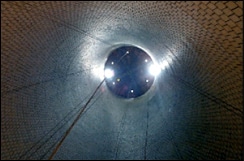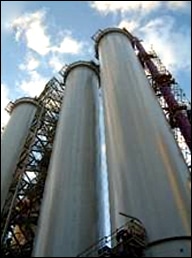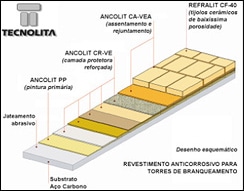Company protected the three largest cellulose pulp bleaching towers ever built

Facing enormous complexity, some projects ended up entering the history of the Brazilian composites industry. The newest to be part of this select group is the anticorrosive coating of three Suzano cellulose pulp bleaching towers, built at the Mucuri plant (BA). Performed by TECNOLITA (Campinas, SP), the work included protection with composite materials from three towers 70 m high by 7.2 m in diameter. “Including the areas of channels and collection wells for the fiber line, the coating totaled an area of
6,000 m², with thicknesses from 5 to 50 mm”, details Günther Reinprecht, director of TECNOLITA.
In addition to the colossal dimensions – according to Reinprecht, so far there is no news of the largest cellulose bleaching towers in the world – TECNOLITA’s work stood out for its speed. “The work was completed in record time: only 120 days,” he says. As for the raw materials applied, the director of TECNOLITA informs that more than 600 tons of anti-corrosion materials from the ANCOLIT® line, manufactured by TECNOLITA itself, and REFRALIT® CF ceramic bricks, imported from Germany, were consumed. “The very low porosity, less than 0.5%, and the high percentage of silicon dioxide, greater than 70%, guarantee ceramic bricks excellent resistance against chemical and thermal attacks, common to the bleaching process. Not to mention that its smoother surface minimizes the friction generated by the pulp flow, ”explains Reinprecht.

DERAKANE MOMENTUM * ester-vinyl resins – supplied by Ara Ashland – served as raw materials for both the ANCOLIT® CA-VEA anti-corrosion cement, used in laying and grouting bricks, and the ANCOLIT® CR-VE reinforced protective layers (both produced by TECNOLITA). “The extreme conditions of the environment demanded the use of high performance resins, as in the case of the DERAKANE * family”, explains Alexandre Jorge, executive of the technical department of Ara Ashland.
During the application of the coatings, Reinprecht points out that TECNOLITA was concerned with monitoring climatic conditions. “We took some precautions so that the temperature of the environment and the substrate, as well as the relative humidity of the air and the dew point, were ideal for the polymerization of the resin”, he describes.
The execution of the lining of the Suzano towers was the responsibility of Georgia Engenharia – with supervision by TECNOLITA – while the implementation of the project was the responsibility of the Finnish group Andritz. “Instead of using traditional tubular scaffolding, we introduced the use of motorized platforms and gondolas, optimizing the time needed for vertical movement”, says Paulo Cabral, technical-commercial manager at TECNOLITA. According to Cabral, this system streamlined the entire process and allowed the applicators to work in the ideal position, that is, at the correct height for the
application of the materials. “In order to comply with the schedule for a covering of this size, we resort to a faster and even safer way of working”, he observes.

Founded in 1992, TECNOLITA is one of the main Brazilian companies in the sector of anticorrosive coatings. According to Reinprecht, the company’s differential is the wide experience of its technical staff. “Like me, other professionals who are part of our team have been working with anticorrosive
coatings for over thirty years. Together, we carried out many of the major projects of the pulp and paper industry in Brazil, accumulating success stories like this one, from Suzano, ”he says. More recently, TECNOLITA was chosen to cover three similar towers in Três Lagoas, Mato Grosso do Sul – a unit known as “Projeto Horizonte”. “The work will be done later this year and will use the same advanced technology that we use at Suzano,” adds Reinprecht.
(*) Registered Trademark of Ashland, Inc.
Source: SLEA Comunicação
Text taken from: http://www.araquimica.com.br/aranews/91/index.html




